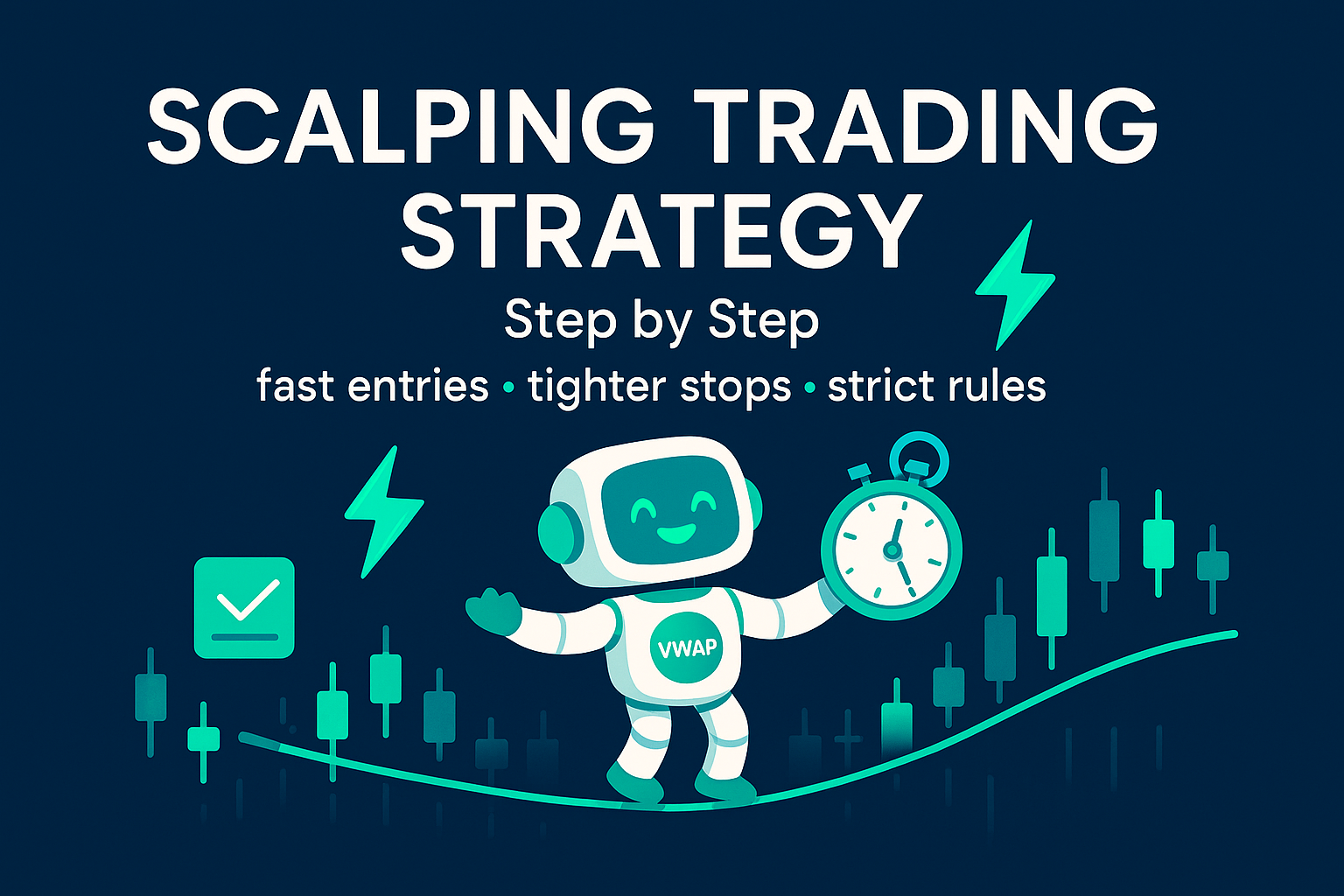Scalping is like trying to catch falling knives while juggling chainsaws on a tightrope. It’s the trading equivalent of performing heart surgery with a shotgun. I’ve made $5,000 in a single morning scalping, and I’ve lost $3,000 in 15 minutes. It’s the most intense, stressful, and addictive form of trading there is, and I’m about to show you exactly how to do it without losing your mind or your money.
Let me be brutally honest – scalping nearly gave me a nervous breakdown. I’m talking chest pains at 28, grinding my teeth so hard I cracked a molar, and my resting heart rate during market hours was 120 BPM. I was making money, but I was also slowly killing myself. It took me three years to figure out how to scalp profitably without destroying my health, and I’m going to save you that pain.
Here’s what scalping really is: making 10-50 trades per day, holding positions for seconds to minutes, trying to grab $0.10-$0.50 moves over and over. It’s death by a thousand cuts in reverse – you’re trying to inflict the cuts. Some days you’re a surgeon, precisely extracting profits. Other days you’re the patient, bleeding out from self-inflicted wounds.
If you’re looking for a chill way to make money, close this article and go learn about dividend investing. But if you’re a sick bastard like me who gets high on adrenaline and thinks normal trading is too slow, welcome to the thunderdome. Let’s learn how to scalp without ending up in therapy.
What Scalping Actually Looks Like (The Reality Check)
Before we dive into strategy, let me show you what a real scalping session looks like, because Instagram traders won’t show you this shit.

Get a VPS from as low as $11/year! WOW!
My Actual Morning from Last Tuesday
4:00 AM PST: Wake up, check futures, scan for pre-market movers
4:30 AM: Set up six monitors with charts, Level 2, time & sales, scanners
5:00 AM: Review economic calendar, identify potential catalysts
5:30 AM: Coffee #1, bathroom break (last chance for 4 hours)
6:00 AM: Mark key levels on SPY, QQQ, and 5 stocks on watch
6:25 AM: Coffee #2, crack knuckles, put on noise-canceling headphones
6:30 AM: Market opens, immediate chaos
6:30-6:35 AM: Watch only, no trades (opening range too wild)
6:35 AM: First trade – SPY bounce off VWAP, long 1000 shares at $478.45
6:36 AM: Out at $478.62, profit $170
6:38 AM: NVDA breaking resistance, long 200 shares at $655.20
6:39 AM: Stop hit at $654.90, loss -$60
6:41 AM: TSLA showing weakness, short 100 shares at $798.50
6:44 AM: Cover at $797.20, profit $130
…and this continues for 3-4 hours straight. By 10:30 AM, I’ve made 23 trades, up $1,240, and I’m mentally exhausted. This is scalping. It’s not sexy. It’s grinding, intense, focused work.
The Numbers That Matter
From my last 1000 scalping trades:
- Average hold time: 3 minutes 42 seconds
- Win rate: 62%
- Average win: $0.35 per share
- Average loss: $0.22 per share
- Daily average: 18 trades
- Monthly profit: $8,000-12,000
- Stress level: 11/10
Notice the win rate is only 62%? That’s because scalping isn’t about being right all the time. It’s about being right slightly more often than wrong, and making your winners bigger than your losers.
The Essential Scalping Setup (Don’t Even Try Without This)
Hardware Requirements
You cannot scalp on your laptop at Starbucks. I tried. Lost $2,000 because my WiFi lagged for 3 seconds. Here’s the minimum setup:
Computer:
- Desktop with at least 16GB RAM
- Processor that won’t lag with 20 charts open
- SSD for quick boot (markets don’t wait for your computer)
Monitors:
- Minimum 2, ideally 4-6
- One for charts, one for execution, one for Level 2, one for scanners
Internet:
- Wired connection (not WiFi)
- Backup connection (mobile hotspot)
- I pay for business internet with guaranteed uptime
My Setup:
- 6 monitors in 2×3 configuration
- Gaming PC (overkill but zero lag)
- Fiber internet + 5G backup
- Total cost: ~$5,000
Yes, it’s expensive. But one missed exit due to lag costs more than the entire setup.
Software Stack
Trading Platform:
- DAS Trader Pro ($150/month) – Direct market access
- Or Sterling Trader Pro ($250/month)
- Or Lightspeed ($130/month)
Don’t even think about scalping on Robinhood or basic platforms. You need:
- Direct market access (skip the middleman)
- Hotkeys for instant execution
- Level 2 with time & sales
- Sub-second order execution
Charting:
- 1-minute chart (primary)
- 5-minute chart (trend context)
- Tick charts (for precise entries)
- Volume profile (see where big money sits)
Scanners:
- Trade Ideas ($118/month) – Best scanner, period
- Or Benzinga Pro ($177/month)
- Or your broker’s scanner if it doesn’t suck
The Data You Need
Level 2: Shows bid/ask depth. Without this, you’re scalping blind.
Time & Sales: Shows actual transactions. This is the tape. Reading it is crucial.
Real-time data: Not delayed quotes. Pay for real-time everything.
Total monthly cost for software/data: ~$400-500. If that seems expensive, scalping isn’t for you. I make that back in 2-3 good trades.
The Only Scalping Strategies That Actually Work
After trying every scalping strategy on YouTube and losing money on most, here are the five that actually work:
Strategy 1: The VWAP Bounce
Volume Weighted Average Price acts like a magnet. Price always returns to it.
The Setup:
- Stock pulls back to VWAP
- Bounces with volume
- Enter long
- Stop below VWAP
- Target: Previous high
Real Trade from Yesterday:
- AMD at $152.30, pulled back to VWAP at $151.80
- Saw buyers stepping in on Level 2
- Long 500 shares at $151.85
- Stop at $151.70
- Sold at $152.20
- Profit: $175 in 2 minutes
Success Rate: 65% win rate, 1.5:1 risk/reward
Strategy 2: The Opening Range Breakout
First 5 minutes establishes the range. Break above or below = momentum.
The Process:
- Mark high and low of first 5-minute candle
- Wait for break with volume
- Enter on retest of breakout level
- Stop below/above the range
- Target: 2x the range
This Morning’s Trade:
- SPY opening range: $479.50 – $480.20
- Broke above at 6:37 AM
- Entered long at $480.25 on retest
- Stop at $479.45
- Target $480.90 (2x range)
- Hit target in 8 minutes
- Profit: $650 on 1000 shares
Success Rate: 58% win rate, 2:1 risk/reward
Strategy 3: The Tape Reading Momentum
This is advanced. You’re reading order flow in real-time.
What to Look For:
- Size hitting the ask repeatedly (bullish)
- Bid dropping on size (bearish)
- Absorption at levels (support/resistance)
Example Pattern:
- See 50,000 shares hitting ask at $100.50
- 100,000 more at $100.51
- Bid holds strong at $100.48
- Clear buying pressure
- Long at $100.52
- Ride momentum to $100.80
This takes months to learn but is the most profitable strategy I use.
Strategy 4: The Level 2 Fake Out
Market makers show fake size to trick retail. We can exploit this.
The Pattern:
- Huge ask at resistance (looks scary)
- Price approaches
- Ask disappears or gets eaten instantly
- Explosive move up
Recent TSLA Trade:
- 50,000 share ask at $800
- Looked like massive resistance
- Watched it carefully on Level 2
- At $799.90, the ask vanished
- Bought immediately at $800.05
- Rode to $802.50
- Profit: $500 on 200 shares
Success Rate: 55% win rate but 3:1 risk/reward when it works
Strategy 5: The Gap Fill
Gaps want to fill. It’s like a law of physics in the market.
The Play:
- Stock gaps up/down at open
- No news to justify gap
- Enter position toward gap fill
- Stop beyond gap extreme
- Target: 50-75% gap fill
Today’s Example:
- NVDA gapped up from $650 to $654
- No news, just market momentum
- Shorted at $653.50
- Stop at $654.50
- Covered at $651.50 (50% fill)
- Profit: $400 on 200 shares
Success Rate: 70% win rate on gaps without news
The Step-by-Step Scalping Process
Pre-Market Preparation (30 minutes before open)
Step 1: Check the Overall Market
- Futures direction and strength
- VIX level (volatility expectation)
- Dollar index (affects everything)
- Bond yields (risk on/off sentiment)
Step 2: Identify Candidates
- Run scanner for pre-market movers
- Check news on each
- Mark yesterday’s high/low
- Note average volume
Step 3: Set Levels
- Mark VWAP from yesterday
- Identify key support/resistance
- Note round numbers ($50, $100, etc.)
- Mark gap levels if applicable
Step 4: Prepare Orders
- Set up hotkeys
- Load positions sizes
- Place alerts at key levels
- Clear yesterday’s executions
The First 30 Minutes (The Chaos Period)
6:30-6:35 AM: Observation Only
- Watch opening drive
- Identify strong/weak stocks
- Let opening range establish
- Note unusual volume
6:35-6:45 AM: First Trades
- Take only A+ setups
- Half normal size (volatility high)
- Wider stops than usual
- Quick profits (don’t be greedy)
6:45-7:00 AM: Momentum Trading
- Full size on clear trends
- Ride winners longer
- Cut losers immediately
- Watch for reversals at round numbers
Mid-Morning (The Sweet Spot)
7:00-9:00 AM: Prime Time
This is when I make most of my money:
- Volatility still good but not crazy
- Patterns more reliable
- Institutions active
- Trends develop
My Routine:
- Trade 3-5 main stocks
- Focus on one strategy
- Scale into winners
- Book profits regularly
Late Morning (Wind Down)
9:00-10:30 AM: Selective Trading
- Volume drops off
- Lunch drift begins
- Only obvious setups
- Reduce size
10:30 AM: Stop Trading
- Review trades
- Calculate P&L
- Note what worked/didn’t
- Prepare for tomorrow
Risk Management for Scalping (Don’t Skip This)
The Position Sizing Formula
Maximum risk per trade = Account size × 0.5%
With a $50,000 account:
- Max risk: $250 per trade
- If stop is $0.25 away: 1000 shares max
- If stop is $0.50 away: 500 shares max
- If stop is $1.00 away: 250 shares max
Never break this rule. EVER.
The Daily Stop Loss
Down 2% of account = STOP TRADING
I don’t care if you see the perfect setup. Your judgment is compromised. Walk away.
My Horror Story: Was down $800, saw TSLA setup, went all in to “make it back.” Lost another $2,200. One revenge trade turned a bad day into a disaster.
The Circuit Breaker Rules
- 3 losses in a row = 15-minute break
- 5 losses in a day = done for the day
- Down $1,000 = reduce size by 50%
- Down $2,000 = stop completely
These rules have saved me tens of thousands.
The Scaling Method
Never go full size immediately:
Entry Scaling:
- Start with 25% position
- Add 25% if working
- Add 25% on momentum
- Final 25% only on confirmation
Exit Scaling:
- Sell 25% at first target
- Sell 50% at second target
- Trail stop on final 25%
This way you lock profits and reduce risk simultaneously.
The Psychology of Scalping (The Part Nobody Talks About)
The Stress Reality
Scalping is fucking stressful. Let me be clear about what you’re signing up for:
- Constant decision making under pressure
- No time to think or analyze
- Every mistake costs money immediately
- One second of hesitation = missed opportunity
- Your heart rate will be elevated for hours
- You’ll sweat even in air conditioning
- Bathroom breaks cost money
- Blinking at the wrong time costs money
My Health Issues from Scalping:
- Developed anxiety disorder
- Chronic neck and back pain
- Eye strain and headaches
- Insomnia (mind wouldn’t stop racing)
- Gained 30 pounds (stress eating)
- Relationship problems (always stressed)
I had to learn to manage this or quit.
The Mental Game
Dealing with Losses:
You’ll have 10+ losses per day. Each one hurts. But they’re just business expenses. Cost of doing business.
My Mental Trick: I pre-write my losses. Before trading, I write “Today I will lose $500 in costs.” When I lose, I’m just paying my budgeted expenses.
Dealing with Wins:
Don’t celebrate until the day is over. I’ve been up $2,000 at 8 AM and finished down $500. Stay focused.
The Focus Requirement:
You cannot check your phone. You cannot talk to people. You cannot eat a real meal. You cannot daydream. For 3-4 hours, you are a trading machine.
The Addiction Problem
Scalping is addictive. The constant action, the dopamine hits from wins, the adrenaline from losses. It’s literally crack for traders.
Signs You’re Addicted:
- Can’t stop checking prices
- Trading when you shouldn’t
- Increasing size for bigger rush
- Lying about losses
- Neglecting everything else
I had to set strict rules:
- Trade only 3 hours per day max
- No trading on weekends
- Mandatory week off every quarter
- Share P&L with spouse (accountability)
Common Scalping Mistakes That Drained My Account
Mistake 1: Overtrading
Taking every setup instead of only the best. More trades ≠ more money.
The Fix: Maximum 20 trades per day. Quality over quantity.
Mistake 2: Holding Too Long
Scalps turning into day trades turning into swing trades turning into investments turning into bags.
The Fix: Maximum hold time 10 minutes. Period.
Mistake 3: Fighting the Trend
Trying to catch reversals instead of following momentum.
The Fix: Trade with the 5-minute trend always.
Mistake 4: Revenge Trading
Lost on NVDA? Immediately trading TSLA to “make it back.”
The Fix: 5-minute cooldown after every losing trade.
Mistake 5: Wrong Time Trading
Trading during lunch or after 10:30 AM when volume dies.
The Fix: Trade only 6:30-10:30 AM. Best opportunities.
Tools and Resources for Scalping
Essential Tools
Hotkeys:
- Buy = F1
- Sell = F2
- Short = F3
- Cover = F4
- Cancel all = ESC
Practice until muscle memory. Speed is everything.
Audio Alerts:
- Price at key level
- Position filled
- Stop triggered
- Unusual volume
You can’t watch everything. Let alerts help.
Educational Resources
Books:
- “Reading Price Charts Bar by Bar” – Al Brooks
- “Mastering the Trade” – John Carter
- “Trading in the Zone” – Mark Douglas
YouTube Channels:
- SMB Capital (actual prop firm training)
- Live Traders (Jared Wesley)
Stay away from anyone promising easy money.
The Practice Regimen
Month 1: Paper trade only. 500 practice trades minimum.
Month 2: Trade 100 shares only. Focus on process.
Month 3: Increase to 200 shares if profitable.
Month 4: Full size if consistently profitable.
Most people skip practice and lose everything. Don’t be most people.
My Daily Scalping Routine (Exact Schedule)
3:45 AM: Wake up (I’m in California)
4:00 AM: Coffee, check futures, scan news
4:30 AM: Set up charts, mark levels
5:00 AM: Review yesterday’s trades
5:30 AM: Identify today’s candidates
6:00 AM: Final preparation, bathroom
6:25 AM: Get in the zone
6:30 AM: Market open – game time
10:30 AM: Stop trading
10:45 AM: Review and journal
11:00 AM: Shut down screens
11:15 AM: Gym (must decompress)
12:30 PM: Normal life resumes
This routine is sacred. Never deviate.
The Reality Check: Should You Even Scalp?
Let’s be brutally honest about whether scalping is for you:
You Should Scalp If:
- You have $25,000+ risk capital
- You can dedicate 4+ hours every morning
- You handle stress well
- You can make split-second decisions
- You’re disciplined about rules
- You can afford to lose money while learning
- You don’t have heart conditions
You Should NOT Scalp If:
- You have a day job
- You’re using money you need
- You’re emotional about losses
- You have an addictive personality
- You want passive income
- You have health issues
- You think it’s easy money
My Scalping Results (The Good and Bad)
Year 1: Lost $15,000 (learning curve)
Year 2: Made $8,000 (barely profitable)
Year 3: Made $45,000 (finally clicked)
Year 4: Made $78,000 (consistent)
Year 5: Made $96,000 (current year pace)
Total time invested: ~4,000 hours
Hourly rate: ~$30/hour after losses
Stress level: Extreme
Health impact: Significant
Would I recommend it? Honestly, probably not
The Bottom Line on Scalping
Scalping is the hardest way to make money trading. It requires massive dedication, expensive tools, iron discipline, and the ability to handle extreme stress. Most people who try scalping lose money and quit within three months.
But if you’re one of the few who can handle it, scalping offers the most consistent daily income possible from trading. No hoping, no waiting, no overnight risk. Just pure, mechanical extraction of profits from market inefficiency.
I make good money scalping, but I’ve paid for it with my health, relationships, and sanity at times. It’s not a career; it’s a job. A stressful, intense, demanding job that happens to pay well if you’re good at it.
If you decide to pursue scalping, start small, practice extensively, and never risk money you can’t afford to lose. And please, for the love of god, set a daily stop loss. The market will always be there tomorrow, but your account might not be if you don’t respect risk.
Scalping isn’t investing. It’s not even really trading. It’s a video game where the points are dollars and game over means bankruptcy. Play accordingly.






